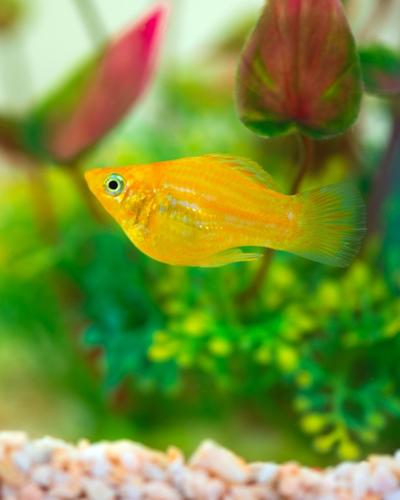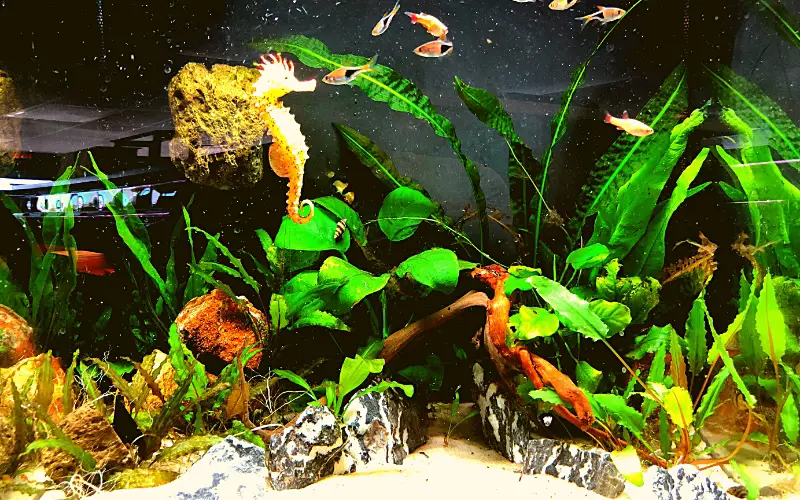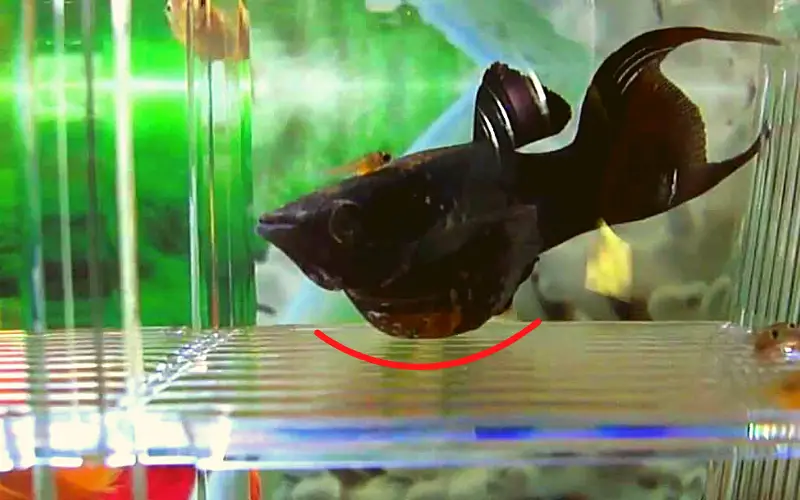Are you worried that your beloved molly fish may be sick or on the brink of becoming ill? So, How to tell if a molly fish is dying or sick? The best way is to look out for a few signs.
In this blog post, we will discuss seven key signs that could indicate a dying molly fish to help you take preemptive action before the situation becomes critical.
From ripples in their fins to changes in their behavior patterns, we’ll explore each symptom in detail and advise how best to address them.

Read this healthy fish care guide carefully if your molly fish exhibits any of these symptoms; it may save its life!
Table of Contents
ToggleHow to Tell If a Molly Fish Is Dying?
How do you know if a fish is dying? A molly fish facing its demise may present a range of warning signs – from hunger loss and infected eyes to swollen gills or discoloration.
It might throw in some extra flair with fin-clamping or even show off strange motion patterns like resting at the bottom.

White specks on the skin may appear while fins fall away too!
These can all be potential indicators of an approaching end – so keep your eye out for them when monitoring your pet’s well-being.
7 Fish Sick Symptoms & Red Flags
If you see any of these signs, you must take action immediately to prevent your fish from getting worse.
Here are the seven significant symptoms of a dying molly fish:
Appetite Loss
You may notice that your molly fish stops eating or is eating less than usual. This could signify several illnesses, such as swim bladder disorder or parasites.
Infected Eyes
If your molly fish has cloudy eyes, it may indicate they suffer from a bacterial infection.
Swollen Gills
This can indicate disease and should be treated promptly to avoid further complications.
Discoloration
A color change could mean the molly fish is ill – whether due to stress or infection, it’s crucial to identify the cause and take action quickly!
Fin Clamping
This can occur for various reasons, including parasitic infections, fin rot, tank water quality issues, or physical injuries caused by other fish in the tank.
Strange Motion Patterns:
If your molly fish is resting at the bottom of the tank or swimming in circles, it could be a sign that they are struggling to stay afloat due to illness or injury.
White Specks on Skin:
These can indicate several illnesses, such as flukes, ichthyophthirius (a parasite), bacterial infections, and fungal infections. These should all be treated promptly with appropriate medications.
If you have noticed any of these symptoms developing in your molly fish, it’s essential to take action quickly!
Monitor its behavior closely and look for other signs of illness – if you don’t think it’s responding well to treatment, contact a local vet for further advice.
It’s always better to be safe than sorry when it comes to the health of your fish, so make sure you keep a close eye on them and take prompt action if necessary.
By following our guide on spotting and treating sick molly, you can help them get back molly fish healthy in no time.
What Causes Molly’s Death?
Molly’s death is often attributed to bad water quality and poor water conditions. Molly fish, also commonly known as balloon mollies, is a species of tropical freshwater fish found in pet stores across the country.
Generally speaking, they are hardy fish that can survive in many different types of water environments.
However, when certain factors like declining water conditions or inadequate living conditions—such as overcrowding or poor filtration—are present, they can die. Poor water quality is one of the leading causes of molly’s death.
When your tank’s levels become too acidic or too basic due to several environmental factors, such as changing temperature, the pH level in your tank will likely become unbalanced, affecting your fish’s health.
Additionally, an abundance of dissolved solids such as phosphate, ammonia levels, and nitrite components from household cleaners and other chemicals used around the tank may also cause pollution in your fish tank leading to serious health problems with your Molly Fish.
If unchecked for an extended period without correction through proper filtration system maintenance or regular weekly/monthly water changes.
These pollutants can then lead directly to death either slowly over time due to weakened immune systems caused by long-term exposure or eventually die due because massive amounts being consumed all at once during feeding times with one particular fish food source containing extremely high levels of nitrates/phosphates etc.

Overcrowding is another issue that prevents optimal livestock well-being within tanks housing molly fish. Not having enough space inside the confines leads directly towards increased stress hormones being produced, weakening immune responses, significantly compromising overall size/colors, etc.
Tap water can be deadly to fish due to chlorine, chloramine, and varying levels of heavy metals.
Protect your aquatic friends by investing in a high-quality filter that eliminates these toxins from their environment.
The nitrogen cycle is critical in creating a healthy and balanced aquatic environment for your fish.
This complex process takes 6-7 weeks to complete, transforming an unsuitable habitat into one where beneficial bacteria can thrive, ultimately providing the perfect place for your finned friends!
Why Is My Molly Fish Sitting at the Bottom of the Tank?
Molly fish should thrive in a healthy tank environment, but swimming near the bottom of the aquarium can be an indicator that something is amiss.
This could mean there are underlying swim bladder conditions or ich present and other reasons like pregnancy.
If you see your molly habitually lingering nearer to the lower depths of their aquatic home, it may point to needing water changes or temperature adjustments for healthier living dynamics!
Swim Bladder Disease Molly Symptoms:
Swim bladder disease is a common ailment in molly fish, caused by poor water quality or nutritional imbalances. Symptoms include floating on one side of the tank, difficulty swimming, and changes in coloration.
If you notice any of these molly fish diseases symptoms developing in your molly fish, it’s essential to take action quickly!
Monitor its behavior and look for any signs of stress or discomfort. If the situation worsens, you may need to adjust the tank conditions, such as pH, water temperature, ammonia and nitrite levels, to help your fish recover.
In some cases, adding medications to your tank may be necessary to treat swim bladder molly fish disease.
You must speak to your local pet store or veterinarian for the best advice on how to proceed.
Finally, it’s important to remember that prevention is vital when dealing with swim bladder molly fish diseases. Make sure you regularly monitor water conditions and provide a balanced diet high in proteins and vegetables.
How Long Do Molly Fish Last?
Keeping Mollies is an exciting and rewarding experience. With striking color variations and unique fin shapes, this fish can bring many years of joy to any aquarium.
Given the ideal environment, they are known for their hardiness and activity even in old age – plus, these extraordinary creatures have been known to produce up to thousands of offspring over a 3-4 year period!
Let us help guide you to becoming a proficient Molly caregiver today!
Do Molly Fish Play Dead?
Molly fish may not be the brightest creatures in the sea, but they certainly know how to survive.
Mollies don’t play dead fish; if your molly is motionless at the bottom of its home, it could mean bad news – this usually indicates health issues or worse.
Don’t delay if you notice an unusual behavior change with your aquatic friend! Be sure to contact a marine veterinarian as soon as possible. They will be able to diagnose and treat any ailment, ensuring that your molly fish live a long and healthy life in its tank!
Why Are My Molly Fish Dying?
Molly fish died suddenly can be worrying for any aquarist. Unfortunately, there are a variety of possible causes for this issue, such as water quality issues (pH, temperature, nitrates/phosphates, etc.), overcrowding, poor diet, or swim bladder disease.
It is crucial to monitor your molly’s behavior and environment closely to ensure that the ideal conditions are being provided. If you notice any signs of sickness or distress, you must act to prevent further losses.
What Does a Fish Look Like When It’s Dying?
To check for signs of life in your aquarium fish, inspect the eye as a whole: sunken eyes usually indicate mortality or imminent death.
Opaque pupils could also be linked to passing away – unless you’re keeping pufferfish, walleye, rabbitfish, or scorpionfish; slight cloudiness is considered normal behavior with these species.
What Do You Do When Your Molly Fish Is Dying?
My molly fish is dying what should I do? If your molly fish is dying, it’s essential to take immediate action as soon as you notice any decline in their health. Here are a few tips:
1. Monitor water parameters: Check the temperature, pH, and other water parameters to ensure they remain within the acceptable range for mollies (72-82°F, 7.2-7.6 pH). Unstable or poor water conditions can harm their health and only worsen if not addressed immediately.
2. Perform regular tank maintenance: Keep up with weekly 25% water changes while vacuuming the bottom of the tank to remove excess waste and uneaten food that builds up over time which can contribute to poor overall health conditions of your fish, including molly, specifically.
3. Provide a varied diet: Feed your molly high-quality flakes or granules as well as live foods such as bloodworms or brine shrimp every couple of days for optimal nutrition so they don’t become malnourished from consuming only one kind of food source that may not contain enough nutrients for them to maintain good health over time.
4 . Create an environment conducive to healing: If aggressive fish in the same tank as your molly could contribute to its decline in health, then consider slowly moving those out into another aquarium while isolating this delicate species. Hence, it has a peaceful place where it can recover without distractions.
To safeguard your new fish health, steer clear of the aquarium heater, which can increase their temperature beyond the acceptable level and lead to fatal consequences.
How Can You Tell If Molly Fish Are Stressed?
Your fish might feel distressed if they are frantically swimming into walls or flopping at the bottom of their tank.
Additionally, watch for signs such as rubbing against gravel, rocks, or fins locked close to their body. If the color of your molly has started to fade or they are exhibiting unusual behaviors like darting and hiding, this could also be a sign of distress.
If any of the above signs are present, it is essential to conversely reduce stress by providing a peaceful and comfortable environment for your aquarium fish.
Is It Normal for Molly Fish to Bottom of Tank?
It is not unusual for healthy molly fish to rest at the bottom of the tank. It could signify that they are sleeping, resting, or bored. If there is no sign of distress and they appear healthy, it is probably nothing to worry about.
Molly fish might reside near the tank’s bottom for several reasons, such as swim bladder infections, ich, and pregnancy.
However, this could also indicate that your aquarium needs to be more optimally suited to their needs – in which case you should consider changing water or adjusting temperature levels.
How to Tell If a Molly Fish Is Male or Female?
With stunning colors and distinctively shaped fins, male mollies provide a captivating sight in their natural habitat.
Easily distinguishable by the backward-pointing anal fin of males compared to that of females, which is indistinguishable from other body fins, these fish are sure to be an eye-catching addition to any aquarium hobby!
How to Tell If a Molly Fish Is Pregnant?
Examine your molly closely to detect signs of pregnancy! Noted indicators include a protruding abdomen, aggression as she defends her space, seeking refuge in secluded hideaways, and an accumulation of pigment forming the gravid patch.

If these signs are present, the female molly is likely pregnant and should be placed in a hospital tank to ensure her safety.
Finally, provide her with a high-protein diet with vegetables and greens to promote healthy fry growth. As they mature, you’ll be able to see the males and females apart from one another, just like with adult Molly fish.
Conclusion
So, how to tell if a molly fish is dying? Your molly will exhibit certain behaviors and characteristics if it is a dying fish. Keep an eye out for changes in swimming patterns, appetite, coloration, and energy levels. Additionally, sick fish often have cloudy eyes, and Threadfin rainbows may also have frayed fins. If you notice these signs in your fish, take immediate action to save them. Changing the water conditions or treating the tank with medication can help revive ailing Molly fish. However, sometimes fish cannot be kept. In these cases, it is important to quarantine the sick fish away from the healthy ones to prevent the spread of disease.
You might also like
- Molly Fish Care: Complete Expert’s Care & Breeding Guide
- Male Vs Female Molly Fish: 6 Ways to Identify Mollies Gender
- What Are Black and Yellow Molly Fish? (A Complete Guide)
- Are Molly Schooling Fish? (9 Compatible Mollies Tank Mates)
- Do Molly Fish Need Light at Night? Turn It Off (Yes or No?)
- Do Molly Fish Sleep on Bottom of Tank (5 Causes & Solutions)





